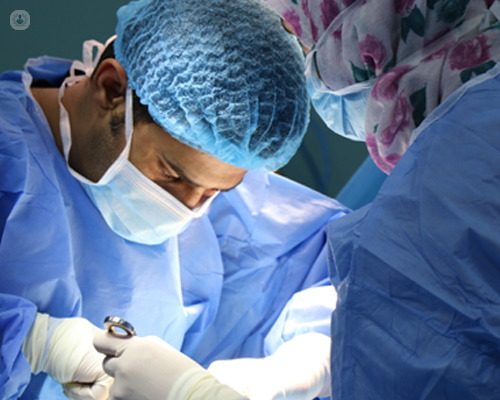Liver surgery for metastatic colorectal cancer
Escrito por:Secondary cancer or metastases is when cancer cells deposit in another location while originating at a completely different primary site.
The origin of secondaries commonly occurs due to deposition of circulating cancer cells via blood, lymphatics and / or via direct spread. In the case of colorectal cancer, secondaries commonly occur in the liver primarily due to deposition of circulating cancer cells via blood through the portal liver circulation.
Early detection, accurate staging and prompt treatment are vital to increase the patient’s chances of survival. Esteemed London-based consultant general and hepato-pancreato-biliary surgeon Mr Deepak Hariharan explains the indication, nature of liver surgery used to treat liver metastases from colorectal cancer.

What is a secondary liver tumour?
Secondary liver cancer or metastases develop when cancer cells are transferred from their site of origin to the liver, typically coming from colorectal, breast, stomach, oesophagus, or skin cancer. If left untreated, the cancer can grow rapidly in both the primary and secondary locations.
The most common cause for secondaries in the liver is due to colorectal cancer. Over half of patients with colorectal cancer, will develop liver metastases. Surgery in combination with chemotherapy is the most effective curative treatment of colorectal liver metastases. The removal of the primary cancer and the liver secondaries in stages with chemotherapy interspersed affects cure.
Occasionally synchronous surgery is offered where initial chemotherapy is administered and on successful completion and assessment - the primary bowel cancer along with the deposit in the liver is removed at the same time.
Who is the ideal candidate for metastatic liver surgery?
Patient's suitability for curative liver surgery for colorectal liver metastases should be assessed based on clinical fitness to proceed for major surgery under general anaesthetic, review of previous surgical / oncological treatment of the primary colon/rectal cancer, appropriate staging scans, such as CT chest/abdomen and pelvis, MRI liver, and whole body FDG-PET scans. Feasibility of curative liver surgery is dependent on the number, location, distribution, size of each metastasis within the liver. It is vital to exclude extra-hepatic disease and ensure adequate volume of remnant liver before proceeding with curative liver surgery.
If cancer has spread further in the body to affect for example the lung and/or bones and/or peritoneum, surgical treatment for the liver may not be considered.
What happens during surgery?
During hepatic resection surgery, the metastases in the liver are identified and parts of the liver affected by cancer deposits are removed. Normally this is achieved through open surgery, but in some cases, it can be done using minimally invasive techniques such as laparoscopy or robotic surgery. Surgeons often use ultrasound to image the lesions noted on preoperative imaging to accurately guide surgical resection. This is to ensure wide margins of clearance to reduce chance of recurrence
Removal of part of the diseased liver requires careful consideration. The surgeon must ensure that enough volume of remnant functioning liver is left behind to avoid liver failure.
Using the liver’s miraculous ability to regenerate, a novel surgical solution is occasionally considered where a two-stage operation liver operation is offered for individual cases after reviewing the number, location of liver metastases. A surgical procedure to clear the less dominant lobe of metastases is combined with a procedure (simultaneously or in a staged manner - radiologically) to disrupt the blood supply to either the right or left branch of the portal vein. This reduces the blood supply to that part of the liver, prompting the contralateral healthy liver to “grow” in volume and function to ensure adequate liver function is retained to survive after the removal of the dominant lobe at second stage liver surgery.
A patient may undergo chemotherapy either prior to and/or after liver surgery.
What happens post-operation?
The patient remains in hospital for 5-10 days depending on the magnitude of liver surgery spending approximately the first 24 – 48 hours hours in intensive care. This allows for close monitoring and support for critical organs such as the heart, lung, kidneys and to to ensure there is no bleeding, bile leakage, infections in blood, wound or chest. It is critical to prevent liver failure and adequately support the remnant liver. Patients should be aware that these are complications that can occur post-liver surgery. A full recovery may take a few months.
What is the prognosis following hepatic resection surgery?
40-58% of patients will extend their life by 5 years if they undergo curative liver surgery. If a patient lives longer than 10 years following their surgery, they can consider themselves cancer free and this is the case for about 17% of patients.
If you would like to book a consultation with Mr Deepak Hariharan, you can do so directly by clicking on his Top Doctors profile.


